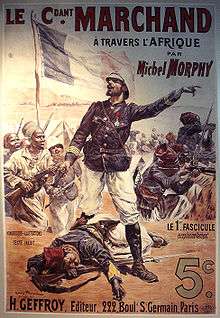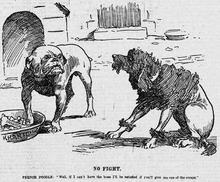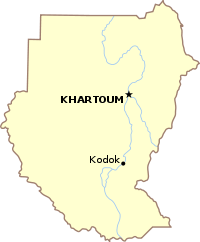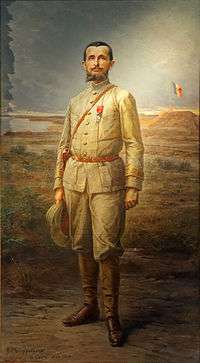Fashoda Incident

The Fashoda Incident or Crisis was the climax of imperial territorial disputes between Britain and France in Eastern Africa, occurring in 1898. A French expedition to Fashoda on the White Nile river sought to gain control of the Upper Nile river basin and thereby exclude Britain from the Sudan. The French party and a British detachment met on friendly terms, but back in Europe, it became a war scare. The British held firm as both nations stood on the verge of war with heated rhetoric on both sides. Under heavy pressure the French withdrew, securing Anglo-Egyptian control over the area. The status quo was recognised by an agreement between the two states acknowledging British control over Egypt, while France became the dominant power in Morocco. France had failed in its main goals. P.M.H. Bell says:
- "Between the two governments there was a brief battle of wills, with the British insisting on immediate and unconditional French withdrawal from Fashoda. The French had to accept these terms, amounting to a public humiliation....Fashoda was long remembered in France as an example of British brutality and injustice."[1]
It was a diplomatic victory for the British as the French realized that in the long run they needed the friendship of Britain in case of a war between France and Germany.[2][3] It was the last crisis between the two that involved a threat of war (until 1940) and opened the way for closer relations in the Entente cordiale of 1904. It gave rise to the 'Fashoda syndrome' in French foreign policy, or seeking to assert French influence in areas which might be becoming susceptible to British influence.[4]
Background
During the late 19th century, Africa was rapidly being claimed and exploited by European colonial powers. After the 1885 Berlin Conference regarding West Africa, Europe's great powers went after any remaining lands in Africa that were not already under another European nation's influence. This period in African history is usually called the Scramble for Africa. The two principal powers involved in this scramble were Britain and France, along with Germany, Belgium, Italy, Portugal, and Spain.[5]
The French thrust into the African interior was mainly from the continent's Atlantic coast (modern Senegal) eastward, through the Sahel along the southern border of the Sahara, a territory covering modern Senegal, Mali, Niger, and Chad. Their ultimate goal was to have an uninterrupted link between the Niger River and the Nile, hence controlling all trade to and from the Sahel region, by virtue of their existing control over the caravan routes through the Sahara. France also had an outpost near the mouth of the Red Sea in Djibouti (French Somaliland), which could serve as an eastern anchor to an east-west belt of French territory across the continent.[6]
The British, on the other hand, wanted to link their possessions in Southern Africa (modern South Africa, Botswana, Malawi, Lesotho, Zimbabwe, and Zambia), with their territories in East Africa (modern Kenya), and these two areas with the Nile basin. Sudan, which then included today's South Sudan and Uganda, was the key to the fulfilment of these ambitions, especially since Egypt was already under British control. This 'red line' (i.e. a proposed railway, see Cape-Cairo railway) through Africa was made most famous by the British and South African political force Cecil Rhodes, who wanted Africa "painted [British] Red".[7]
If one draws a line from Cape Town to Cairo (Rhodes' dream) and another line from Dakar to French Somaliland (now Djibouti) by the Red Sea in the Horn (the French ambition), these two lines intersect in eastern South Sudan near the town of Fashoda (present-day Kodok), explaining its strategic importance. The French east-west axis and the British north-south axis could not co-exist; the nation that could occupy and hold the crossing of the two axes would be the only one able to proceed with its plan.
Fashoda was also bound up in the Egyptian Question, a long running dispute between the United Kingdom and France over the legality of the British occupation of Egypt. Since 1882 many French politicians, particularly those of the parti colonial, had come to regret France’s decision not to join with Britain in occupying the country. They hoped to force Britain to leave, and thought that a colonial outpost on the Upper Nile could serve as a base for French gunboats. These in turn were expected to make the British abandon Egypt. Another proposed scheme involved a massive dam, cutting off the Nile’s water supply and forcing the British out. These ideas were highly impractical, but they succeeded in alarming many British officials.[8]
Stalemate

A French force of just 120 tirailleurs (Senegalese infantrymen) plus 12 French officers, non-commissioned officers and support staff — Captain Marcel Joseph Germain, Captain Albert Baratier, Captain Charles Mangin, Captain Victor Emmanuel Largeau, Lieutenant Félix Fouqué, teacher Dyé, doctor Jules Emily Major, Warrant Officer De Prat, Sergeant George Dat, Sergeant Bernard Sergeant Venail and the military interpreter Landerouin — set out from Brazzaville in a borrowed Belgian steamer, under Major Jean-Baptiste Marchand with orders to secure the area around Fashoda, and make it a French protectorate. They steamed up the Ubangi River to its head of navigation and then marched overland through jungle and scrub to the deserts of Sudan. They travelled across Sudan to the Nile River. They were to be met there by two expeditions coming from the east across Ethiopia, one of which, from Djibouti, was led by Christian de Bonchamps, veteran of the Stairs Expedition to Katanga.[9]
After a difficult 14-month trek across the heart of Africa, the Marchand Expedition arrived on 10 July 1898, but the de Bonchamps Expedition failed to make it after being ordered by the Ethiopians to halt, and then suffering accidents in the Baro Gorge. Marchand's small force was thus alone.[10] On 18 September a flotilla of five British gunboats arrived at the isolated Fashoda fort. They carried 1,500 British and Egyptian/Sudanese soldiers, led by Sir Herbert Kitchener and including Lieutenant-Colonel (later General) Horace Smith-Dorrien.[11] Marchand had received incorrect reports that the approaching force consisted of Dervishes but now found himself facing a diplomatic rather than a military crisis.[12]
As the commander of the Anglo-Egyptian army that had just defeated the forces of the Mahdi at the Battle of Omdurman, Kitchener was in the process of reconquering the Sudan in the name of the Egyptian Khedive, and after the battle he opened sealed orders to investigate the French expedition. Kitchener, a fluent French speaker, landed at Fashoda wearing Egyptian Army uniform, and the two commanders behaved with admirable restraint. Both sides insisted on their right to Fashoda but agreed to wait for further instructions from home.[13]
News of the meeting was relayed to Paris and London, where it inflamed the imperial pride of both nations. Widespread popular outrage followed, each side accusing the other of naked expansionism and aggression. The crisis continued throughout September and October. The Royal Navy drafted war orders and mobilized its reserves.[14]
Resolution

In naval terms, the situation was heavily in Britain's favour, a fact that French deputies acknowledged in the aftermath of the crisis. Significant credit has been given to Marchand for remaining calm.[15]
The military facts were undoubtedly important to Théophile Delcassé, the newly appointed French foreign minister. He saw no advantage in a colonial war with the British, especially since he was keen to gain their friendship in case of any future conflict with Germany. He therefore pressed hard for a peaceful resolution of the crisis. The reopening of the Dreyfus Affair had done much to distract French public opinion from events in the Sudan and with people increasingly questioning the wisdom of a war over such a remote part of Africa, the French government quietly ordered its soldiers to withdraw on 3 November and the crisis ended peacefully.[16] Marchand chose to withdraw his small force by way of Abyssinia and Djibouti, rather than cross Anglo/Egyptian territory by taking the relatively quick journey by steamer up the Nile.[17]
Effects


In March 1899, the French and British agreed that the source of the Nile and the Congo rivers should mark the frontier between their spheres of influence.
The Fashoda incident was the last serious colonial dispute between Britain and France, and its classic diplomatic solution is considered by most historians to be the precursor of the Entente Cordiale.[18]
The two main protagonists are commemorated in the Pont Kitchener-Marchand, a 116-metre road bridge over the Saône, completed in 1959 in the French city of Lyon.
See also
- Fashoda, the village in South Sudan, is now known as Kodok
- France–United Kingdom relations
- International relations of the Great Powers (1814–1919)
References
- ↑ P. M. H. Bell (2014). France and Britain, 1900-1940: Entente and Estrangement. Routledge. p. 3.
- ↑ A.J.P. Taylor, The Struggle for Mastery in Europe, 1848-1918 (1954) pp 381-88
- ↑ D.W. Brogan, France under the Republic: The Development of Modern France (1870-1930) (1940) pp 321-26
- ↑ William L. Langer, The diplomacy of imperialism: 1890–1902 (1951) pp 537–80
- ↑ Thomas Pakenham, Scramble for Africa: The White Man's Conquest of the Dark Continent from 1876–1912 (1991)
- ↑ William Roger Louis, and Prosser Gifford, eds. France and Britain in Africa: imperial rivalry and colonial rule (Yale University Press, 1971).
- ↑ Louis and Gifford, eds. France and Britain in Africa: imperial rivalry and colonial rule (1971).
- ↑ Henri L. Wesseling, Divide and conquer: The partition of Africa, 1880–1914 (1996).
- ↑ Michel Côte, Mission de Bonchamps: Vers Fachoda à la rencontre de la mission Marchand à travers l’Ethiopie, Paris, Plon, 1900.
- ↑ Levering Lewis, David: The Race to Fashoda, Weidenfeld & Nicolson, New York (1987, 1995) pp. 133, 135, 210.
- ↑ Pakenham, Thomas. The Scramble for Africa. p. 548. ISBN 0-349-10449-2.
- ↑ Pakenham, Thomas. The Scramble for Africa. p. 547. ISBN 0-349-10449-2.
- ↑ Alan Moorehead, The White Nile, Hamish Hamilton, London, 1962, also published by Penguin
- ↑ Pakenham, Thomas. The Scramble for Africa. p. 552. ISBN 0-349-10449-2.
- ↑ Morrison Beall Giffen, Fashoda, the Incident and Its Diplomatic Setting (1930) pp 78–98 online]
- ↑ William L. Langer, The diplomacy of imperialism: 1890–1902 (1951) pp 537–80
- ↑ Pakenham, Thomas. The Scramble for Africa. p. 555. ISBN 0-349-10449-2.
- ↑ Horne, Alistair (2004). La Belle France. USA: Vintage. pp. 298–299. ISBN 978-1-4000-3487-1.
Further reading
| Wikimedia Commons has media related to Fashoda Incident. |
- Andrew, G. M.; Kanya-Forstner, A. S. (1974). "Gabriel Hanotaux, the Colonial Party and the Fashoda Strategy". Journal of Imperial Commonwealth History. 3 (1): 55–104. doi:10.1080/03086537408582422. (subscription required (help)).
- Bates, Darell The Fashoda incident of 1898: encounter on the Nile. (Oxford UP, 1984, ISBN 0-19-211771-8)
- Brown, Roger Glenn. Fashoda reconsidered: the impact of domestic politics on French policy in Africa, 1893–1898 (Johns Hopkins University Press, 1970)
- Eubank, Keith (Spring 1960). "The Fashoda Crisis Re-Examined". Historian. Wiley. 22 (2): 145–162. doi:10.1111/j.1540-6563.1960.tb01649.x. (subscription required (help)).
- Giffen, Morrison Beall. Fashoda, the Incident and Its Diplomatic Setting (University of Chicago Press, 1930) online
- Langer, William L. The diplomacy of imperialism: 1890–1902 (1951) pp 537–80, a standard diplomatic history
- Levering Lewis, David The Race to Fashoda: European Colonialism & African Resistance in the Scramble for Africa. (New York: Weidenfeld & Nicolson, 1987,ISBN 1-55584-058-2)
- Porter, Charles Wesley. The Career of Théophile Delcassé (Greenwood Press, 1975) online pp 132–39
- Riker, T. W. (March 1929). "A Survey of British Policy in the Fashoda Crisis". Political Science Quarterly. 44 (1): 54–78. doi:10.2307/2142814. JSTOR 2142814.
- Taylor, A.J.P. (January 1950). "Prelude to Fashoda: The Question of the Upper Nile, 1894-5". English Historical Review. 65 (254): 52–80. doi:10.1093/ehr/lxv.ccliv.52. JSTOR 556548.
- Wright, Patricia (1972). Conflict on the Nile: the Fashoda incident of 1898. London: Heinemann. ISBN 0-434-87830-8.
Primary sources
- Churchill, Sir Winston (1902). The River War: An Account of the Reconquest of the Sudan. Chapter 17 is devoted to Fashoda, covering actions on the ground more than international diplomacy. It is available online at: Project Gutenberg Edition of The River War.
Coordinates: 9°53′N 32°07′E / 9.883°N 32.117°E
